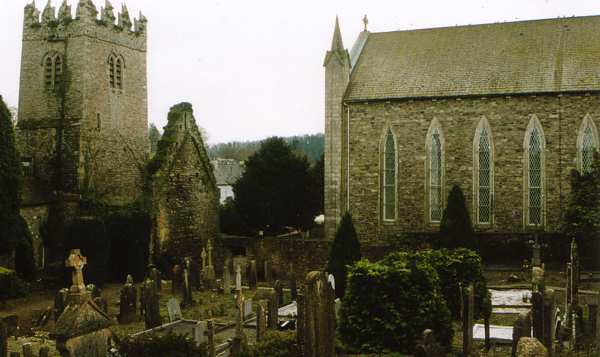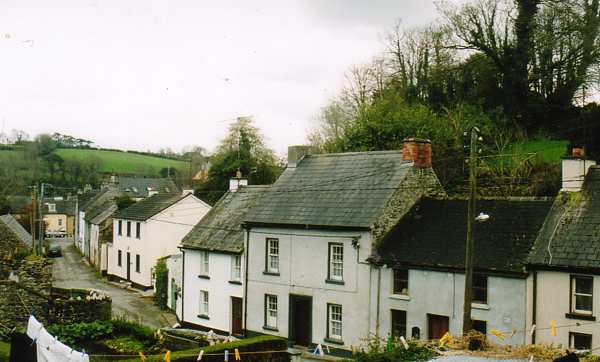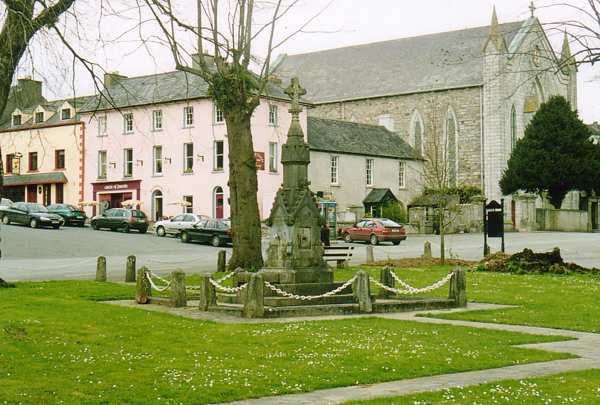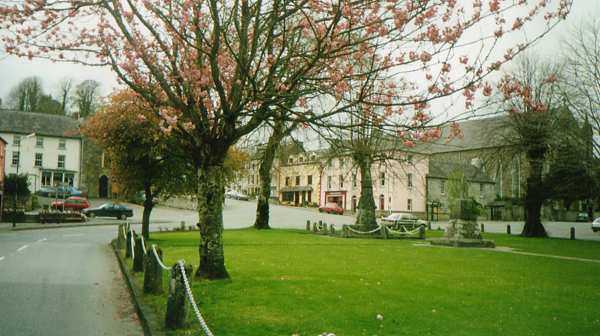 |
|
THE HANDSTAND |
JULY 2003 |
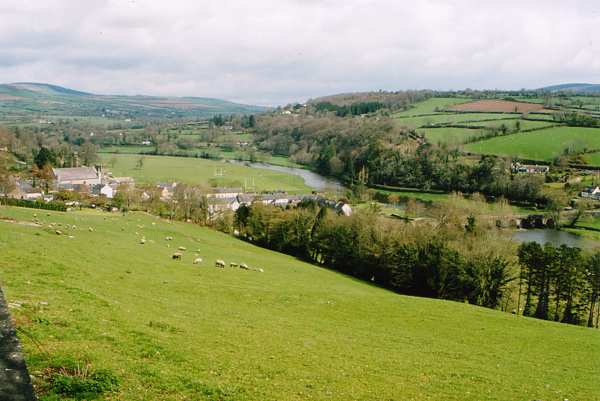 The
small community of Inistioge,under the care of the Bishop
of Ossory, Bishop Brownrigg, and Fr.Nolan PP,was, in
March 1900,the first community in Ireland to herald the
new era of ecumenism nearly a hundred years before
everybody else .....(photo from Woodstock Estate Gate,
houses were removed along this wall right so that a view
was maintained on the drive downhill to the village). The
small community of Inistioge,under the care of the Bishop
of Ossory, Bishop Brownrigg, and Fr.Nolan PP,was, in
March 1900,the first community in Ireland to herald the
new era of ecumenism nearly a hundred years before
everybody else .....(photo from Woodstock Estate Gate,
houses were removed along this wall right so that a view
was maintained on the drive downhill to the village).THE
FUNERAL Lady Louisa died on the 8th
March l900, this story,as witnessed by Thomas Whyte when
he was 12 yrs of age, was subsequently written up when he
was 17 yrs old and all the facts verified by E.J.(Ned)
Roberts. On Sunday 25th of February of that year Father Nolan PP, prayed at both Masses in St.Colmcille’s Catholic Church for Lady Louisa, as word had reached him that she had a heavy cold and was not responding to treatment. The heir to the estate of Woodstock, Mr. Edward Tighe and other family members had arrived from England. Father Nolan on the following Sunday gave his congregation the news that she had died peacefully on Thursday. He offered up prayers for the repose of her soul, "though not a Catholic, this gracious lady, whose generosity knew no bounds, and whose concern for 'her people' in Inistioge was legendary." He said that the funeral arrangments were not yet complete,and requested that every Catholic family in the parish should attend the funeral as a tribute to this wonderful lady who had lived amongst them for 75 years. Fr. Nolan was visibly moved as he recited the prayers.
On Monday 5th March, before noon, Fr. Nolan visited both the boy’s and the girl’s schools to announce that Lady Louisa’s funeral would take place on Thursday 8th March at 12.00 noon.The priest, teachers and pupils offered up prayers, and many youngsters showed signs of distress at this sorrowful news.He asked the children to alert neighbours who did not have children going to school. He had received a telegram from Bishop Brownrigg stating that he was attending the funeral, Lady Louisa on her death-bed had requested this.The Bishop stated that a Solemn Requiem Mass would take place on Friday 9th at 11.30 am. The school would be closed on Thursday and Friday and Fr.Nolan granted a half day to the pupils on Monday as a mark of respect. He hoped that the shops would be closed on Thursday. Also, Canon Beresford visited the Church of Ireland mixed school on that day to announce the funeral arrangements. He requested that pupils and parents would attend the ceremonies. During the week there was great
activity in the village. Thursday was a very fine day, it was'nt cold, the sky was clear and there was no wind. My mother and our family left Cappagh in our pony and trap. When we arrived at the Rock Road there were close on 20 traps and carts tethered at the roadside, so we walked to the village. When we reached the Bridge people were coming from all directions, from Graigue and from the New Ross Road. There was a RIC Constable on duty to stop all through traffic. He said there would be no police on duty in the village at the request of Mr, Tighe.We all converged on the green… people made sure that the roadway from Woodstock remained clear. An area outside Cody’s Hotel was roped off, so that visiting dignitaries could freshen up, the dining room was fully booked as even Woodstock with an augmented staff could not cope with the influx of mourners.At least 20 carriages were ordered by Mr. Tighe to convey people from Thomastown station, every large house in the County provided carriages, the Marquess of Ormonde providing his best carriage for the Viceregal party. At 11.50 Bishop Brownrigg in full Liturgical dress preceded by 2 priests in choir dress who looked slightly ill at ease, left St.Colmcille’s Church and entered St. Mary’s, where they were greeted by Canon Beresford, and taking their places in the choir were welcomed by the Church of Ireland, Bishop of Ossory, John Baptiste Crozier. At that time a great and uncanny silence fell on the village, the air was still, there was no shuffling feet or conversation, the people waited. At 11.55 the footsteps of men in step were heard as the cortege came down, all the estate workers, including the retired staff marched ahead of the funeral carriage. Eight young men of equal height, with bowler hats and white gloves walked 4 each side of the carriage, they were the pallbearers. The carriage completely draped in black and the coffin strapped down on a special frame. The only item on the coffin was a flag. Edward Tighe, the 6th Duke of Richmond and his son Lord Gordon Lennox, Lt.Colonel James Stuart Tighe, the head of the Roseanna family a sprightly 69yr.old gentleman and his eldest son Walter Stuart Tighe followed the cortege on foot, as did most other male relatives who had walked from Woodstock. The elderly coachman taking her Ladyship on her last journey tried to hide his tears. Both he and the footman wore silk hats draped in black and morning suits. Just as the cortege halted the bells of both churches pealed out, the bells of the Catholic Church were also for the Angelus.The coachman and boy removed their hats and bowed their heads in prayer, as did every man and boy in the square outside, the women blessed themselves, the only sound the pealing of the bells. The Church of Ireland mourners removed their hats and stood silent; it was a wonderful thing to behold. The carriages with the ladies and elderly mourners were not opened until the bells were silent.
Immediately after the cortege entered St. Mary’s, all the people in the square proceeded in an orderly way to the Catholic graveyard. Taking access to the common graveyard by way of the entrance to the C. of I churchyard; where the Catholics were buried on the left and the C.of I parishioners to the right, in the large sloping, tiered, cemetery there must have been close on 400 people gathered. I had a good position close to the mausoleum and had a good view. Atlast the service was over. The coffin was shouldered by the pallbearers, followed by the family mourners only out of the church. Both Bishops imparted their blessings, which were clearly heard in the still air. As the prayers ended an amazing thing occurred. The local brass band, which was financially helped by Lady Louisa for the enjoyment of the villagers, struck up the hymn ‘Abide With Me’, they had taken their places unobtrusively beside the mausoleum. It was a spontaneous gesture, some of the bandsmen were estate employees and wanted to pay their own tribute to Lady Louisa. The sound covered the entire cemetery, in unison all of the people sang the hymn and practically everyone including the family were in tears. As the mourners left, the Duke and Edward Tighe both overcome, bowed towards the vast number of people assembled there. The people then wound their way silently out of the village. On Friday morning we attended Mass at 11.30, again horses and carts were tethered along the Rock Road. There were droves of people, Catholic and Church of Ireland who converged in the Church. The Church and side aisles were packed, as was the Choir Gallery. A catafalque draped in black was outside the altar rails. Three pews were set up in the Sanctuary. The Parish Priest in choir dress was Master of Ceremonies and escorted the Tighe family, the Duke and Duchess of Redmond and the Marquess and Marchioness of Ormonde to the pews in the Sanctuary. At ll.30 sharp the sacristy door opened and Bishop Crozier and Canon Beresford, followed by Bishop Brownrigg, the Vicar General and the Curate. The Church of Ireland clergymen took their places in the Sanctuary and the Catholic clergy stood before the high altar in accordance with liturgical rubrics. In contrast to yesterday the Bisho who was a celebrant did not wear his Liturgical dress, instead he wore the black chasuble, as did the other priests. The only indication of his office was the purple biretta, which he then removed, and the zucchetto (skull cap) which he wore throughout the Mass, and his pectoral cross. The Mass was in Latin and after the Gospel the Bishop proceeded to the pulpit and removed the zucchetto.. Always an austere man he looked particularly austere today. He was renowned for his oratory. He gave a powerful and moving oration. The Church was silent, it appeared as if the entire congregation held their breath. He said “This is both a sad day
and a joyful day. Sad because we have laid to rest Lady
Louisa Madeleine Tighe, who came to Woodstock as William
Tighe’s bride in 1825 and was chatelaine of
Woodstock for 75 years. It is indeed joyful -
to see the people of Inistioge, friends and neighbours,
Catholic and Church of Ireland joining together in the
Church of St. Colmcille to pay tribute and give thanks
together for her charity and good works over such a long
period. Yesterday the aristocratic ascendancy, including
the Queen’s representative, the Viceroy Earl of
Cadogan and his court, had travelled long distances to
pay homage to a famous lady of Royal connection. It
resembled a state funeral and I wish to thank you, the
ordinary people of Inistioge, who turned out en masse
yesterday and again today in silent tribute. It is
indeed awesome to see people of both religions sitting
together in this church today, and yesterday in St.
Mary’s , because your homage to this great lady
overcame for these few days the difference in our
culture. Next week people will return to their usual
places of worship, and as I look at you today, I am
wondering if the day will come, when people of all
religions will come together, naturally and uninhibited.
To bury their dead, to attend marriages, and special
occasions and yet retain their different ethos. This day
will come dear brethren, perhaps not in my time, but
before the 20th Century ends. It will be a
gradual breakthrough, we adore the same God, and our
ceremonies are similar in many ways. The Lord whom
we worship will bring us together, after all we are
neighbours and friends and the fact that we can enter
either church, without looking over our shoulders to see
if we are observed will enrich that friendship which now
exists and is so obvious today. “Lady Louisa was years ahead of everyone in her Ecumenical thinking. When the last Parish Priest Canon Hennessy died in 1895, she contacted me to say she would like to attend the funeral of an old and valued friend. I assured her of the welcome she would receive. She came with Catholic members of her staff and her good friend Canon Beresford, who read one of the lessons – as Bishop Crozier and Canon Beresford participated in the ritual today. When Bishop Crozier and I gave the final blessings yesterday, we may have used different wording but the meaning was the same.” The Bishop paused for a full moment and when he spoke his tone was cold and measured. He said, “In this diocese there is a perception, which states if a Catholic enters a place of worship other than a Catholic Church, for a funeral or other function, then it is inferred that such a Catholic has participated in the ritual of that place of worship. The perception is that this Catholic has sinned, not an ordinary sin, but a reserved sin, and the unfortunate sinner has to go to the Bishop for absolution as the bishop alone can resolve a reserved sin. Twice in the past 16 years I was approached about this and I gave it short shrift, as I will give short shrift to anyone who approaches me after this funeral. This is not the teaching of the Catholic Church, it never was and never will be If this stupid bigotry remains in people’s minds, there will never be any sort of reconciliation of our different ethos. I want the message to go forth from this church today, that this perception is incorrect. It may be the practice in other diocese, but I am speaking as the Bishop of Ossory only.”
There was an audible gasp in the church and the Church of Ireland clergymen were seen to nod their heads in agreement. He then resumed his homily about Lady Louisa, at times his voice broke as he recalled some incident. He continued, “When Fr. Thomas Hennessy came to Inistioge in 1863 Lady Louisa wrote to him, welcoming him to the parish, and asked him to call as she had something to discuss. One of her Catholic servants had died, and her Ladyship wished to bear the cost of the funeral. Fr. Hennessy agreed and that was the beginning of a long and pleasant relationship. The present Parish Priest. Fr. Nolan, visited her on several occasions, and it was Fr. Nolan who arranged this service. I came to Ossory in October 1884, and when I came to Inistioge for Confirmation the following year, the Woodstock carriage was outside the Church, with an invitation to lunch for Canon Hennessy, Vicar Forane of the Southern Deanery and myself. We gladly accepted this gracious invitation, and for me it was the start of a long and enriching friendship which only concluded yesterday. On her death bed she requested my attendance and I felt privileged to be here. “My predecessor, Bishop Moran, visited Woodstock once; he was a saintly and retiring man, not an extrovert like me. He went on to become Cardinal Archbishop of Sydney. I had some wonderful days in Woodstock – up to the end she was fully aware of what was happening in Ireland. Not so long ago she said: ‘Abraham I am very concerned about the political situation in Ireland. I am here so long I consider myself as Irish as the Irish. There are trou bled times ahead and I hope that I will not see them.’ “On another occasion there was a very robust discussion about Irish politics. And I remarked on her knowledge. She replied with that tingling laugh, ‘ I was well taught by my dear William, all of the Tighe men were exceptionally clever, and they were true Irishmen with a deep sense of the Irish situation. My William’s father was one of the foremost men in opposing the Act of Union. He was concerned that the Catholics would come out of it badly, and they did.’ “Her interest in the gardens was great. She felt that William and herself had created something which would give immense pleasure for many generations to come……She said to me (on another occasion), ‘Abraham, I had a good life, I had a wonderful husband, a kind man who cared for his staff and his tenants, it grieved us both that sometimes our actions were misunderstood….. I consider the people of Inistioge, particularly the villagers, to be my people; I was not concerned about their religion, we all pray to the same God. But there is more to life than praying, and someone with my privileges had a God given duty to help out our less fortunate friends whether they were our staff, our tenants or anyone who needed us.’ She passed her 97th birthday, she was as alert as she was when I met her first. She was frail in body, a little old lady with a heart of gold. May the Good Lord have Mercy on the soul of a special lady, a true Irishwoman, who helped so many in her lifetime. Woodstock will never be the same again, the halcyon days are over. I would like on your behalf to welcome Mr, Edward Tighe, his wife Viola, and family to Woodstock. He has owned the Estate for 10 years, but respected the Last Will of William Tighe, which stipulated that Lady Louisa would reside in the house until her death. He will continue the Woodstock tradition, it will now be his home, and I know that the good people of Inistioge will continue their loyalty to him. This is a two way street. I would ask Edward Tighe to recognise the loyalty of the ordinary people of Inistioge which was displayed here today. When Mass is over and when the clergy retire Edward Tighe and the Duke of Richmond would like to meet everyone. They will stand beside the catafalque and will greet the people present. I would ask you to reciprocate the gesture of goodwill.” He then replaced the zuccetto, and as he left the pulpit his eyes were full of tears. After the Mass the people came up as
requested and it took practically an hour before the
family could leave. Again the people returned to
their homes. They had much to reflect on and Bishop
Brownrigg’s oration was something that many people
took to their graves. It was a strange experience,
but a good one. People knew they would never see or hear
the same again. In later years I hear that details of
this famous oration spread through the entire diocese. The author
appended a note after this text relating:”When
Ireland’s first President, the scholarly Dr, Douglas
Hyde died, his funeral was from St.Patrick’s
Cathedral, C of I Dublin. To their shame his successor
and all the Government and Dail, all Catholics stood
outside the Church during the service. They all drove to
Roscommon (to the burial) and again no one entered the
Church. We were the laughing stock of Europe. Heads of
other Nations came and they were amazed.”
GHOSTS OF
OTHER DAYS |
|
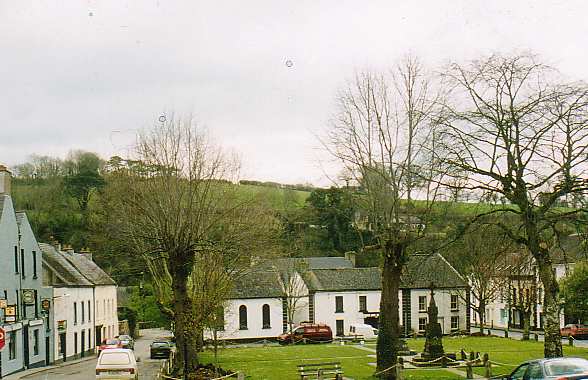
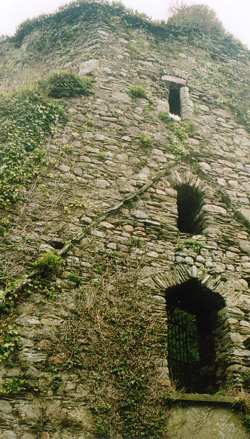 the great
the great 